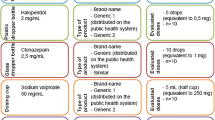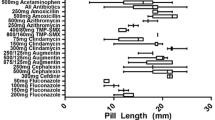Abstract
Background: Tablet splitting is used in pharmacy practice to adjust the dose to be administered. It is also being advocated as a method of reducing prescription drug costs.
Methods: The potential for using this practice as a cost-saving method was examined. The top 200 prescription products in Canada were evaluated for their potential for tablet splitting to reduce costs. The assessment was based on the dosage form (only tablets could be split), availability of dosages in multiples, whether the drug was used for long-term therapy, whether the product was packaged suitably (e.g. oral contraceptives in a therapeutic package), whether pricing structure would allow substantial saving, and the physical nature of the tablets (e.g. whether there were special dose-release characteristics). The products most commonly split in three Canadian pharmacies were compared with the products that had a substantial savings potential. Costs for splitting tablets in the pharmacy and costs of instructing patients to split tablets were calculated.
Results: Savings could be generated from tablet splitting for only 15 of the 200 products. There was little overlap between these 15 products and the products that were most frequently split in the three pharmacies. The costs associated with tablet splitting in the pharmacy were approximately 0.1 Canadian dollars ($Can) per tablet. The cost of instructing a patient to split the tablets was approximately $Can1.
Conclusions: Tablet splitting appears to have limited usefulness as a cost-reduction strategy. Only a small proportion of products are suitable for splitting and have the potential for savings. There are also costs arising from splitting tablets in the pharmacy, or instructing patients to do so, and from wastage of product. There are also issues such as patient compliance and the risk of an incorrect dose being taken that should be considered.




Similar content being viewed by others
Notes
Use of tradenames is for product identification only and does not imply endorsement.
References
Rochon PA, Clark JP, Gurwitz JH. Challenges of prescribing low-dose drug therapy for older people. CMAJ 1999; 160: 1029–31
Kawachi I. Economic factors in the initiation of antihypertensive therapy. Pharmacoeconomics 1992; 2 (4): 324–34
Gupta P, Gupta K. Broken tablets: does the sum of the parts equal the whole? Am J. Am J Hosp Pharm 1988; 45: 1498
McDevitt JT, Gurst AH, Chen Y. Accuracy of tablet splitting. Pharmacotherapy 1998; 18: 193–7
Sedrati M, Arnaud P, Fontan JE, et al. Splitting tablets in half. Am J Hosp Pharm 1994; 51: 548, 550
Schultz P, Moran K, Hogan T, et al. Evaluation of three methods of administering atorvastatin [poster presentation]. Florida Society of Health-System Pharmacists 1999 Annual meeting: 1999 Mar 26–8; Fort Lauderdale (FL)
Fawell NF, Cookson TL, Scranton SS. Relationship between tablet splitting and compliance, drug acquisition cost, and patient acceptance. Am J Health Syst Pharm 1999; 56: 2542–5
Ministry of Health. Barbados National Formulary. 20th ed. Barbados: Ministry of Health, 1999
Half-tablets: cost effective and easy to do! Patient instruction information distributed by Kaiser Permanente (NC). Data on file
Keeling S. Confusing the patient [letter]. Pharm J 1999 Oct 16; 263: 63
Atkin PA, Finnegan TP, Ogle SJ, et al. Functional ability of patients to manage medication packaging: a survey of geriatric inpatients. Age Aging 1994; 23: 113–6
Carr-Lopez SM, Mallett MS, Morse T. The tablet splitter: barrier to compliance or cost-saving instrument? Am J Health Syst Pharm 1995; 52: 2707–8
Top 200 dispensed products by number of prescriptions -1998. Academic Reference Manual. 3rd ed. Montreal: IMS Health, 1999
Bachynsky J, Dabisza S, Sullivan K, et al. Cognitive services, pharmacist valuation of service fees. Can Pharm J 1997; 130: 26–7, 30-1
Acknowledgements
Research funding was obtained from the Faculty of Pharmacy and Pharmaceutical Sciences, University of Alberta, Canada. Information on the leading products and their average monthly prescription quantity was provided by IMS Health. There is no declared conflict of interest in this study by the authors.
Author information
Authors and Affiliations
Corresponding author
Rights and permissions
About this article
Cite this article
Bachynsky, J., Wiens, C. & Melnychuk, K. The Practice of Splitting Tablets. Pharmacoeconomics 20, 339–346 (2002). https://doi.org/10.2165/00019053-200220050-00005
Published:
Issue Date:
DOI: https://doi.org/10.2165/00019053-200220050-00005




